Send your good work in the knowledge base is simple. Use the form below.
Students, graduate students, young scientists who use the knowledge base in their studies and work will be very grateful to you.
Posted on http://www.allbest.ru/
Introduction
preschool education program
"Of all the sciences that a person should know
The main thing is the science of
how to live doing as little evil as possible
and as much good as possible. ”
(L.N. Tolstoy)
Modern system of domestic preschool education based on the principles of dynamism, variability of organizational forms, flexible response to the needs of society and the individual, characterized by the emergence of new types of educational institutions for children, a variety of educational services.
Among the factors affecting the efficiency and quality of education of children in pre-school educational institutions, an important role belongs to the educational program. It is a guideline for creative activities of educators: it determines the content of the educational process in pre-school, reflects the ideological, scientific and methodological concept of preschool education, fixes its content in all major areas of child development. In accordance with the focus and level of program implementation, the type and category of pre-school educational institutions are established.
The modern differentiation of preschool education, the diversity of types of preschool educational institutions suggest a significant variation in the use of programs and pedagogical technologies, while respecting the unity of the main goals and objectives of preschool education.
The main programs of preschool education determine the content of the preschool level of education, its level and orientation, based on the priority goals and objectives. They guarantee the level of education that is necessary and sufficient for the full development of the child.
The integrity of the educational process can be achieved not only by using one main program, but also by the method of qualified selection of specialized programs, each of which includes one or several areas of child development. The main programs determine the features of the organization of children's life in the context of ensuring all its aspects and taking into account the use of the following forms of children's activities: classes as a specially organized form of education; unregulated activities; free time during the day.
Excursion in history
Analyzing the current state of the organization of the pedagogical process and the regulatory software of preschool institutions, it is advisable to make a brief history.
Preschools were guided in their work by the “Education and Training Program in kindergarten”, Which from 1962 to 1982 was republished 9 times and was a single mandatory state document. In it was determined the amount of ideas, knowledge, skills and abilities that needed to be raised in each child. Work on a strictly regulated program inevitably limited the possibilities for pedagogical creativity, did not sufficiently take into account the individual characteristics of children, suppressed the natural curiosity of the child, and led to formalism.
In 1989, the State Committee on Public Education of the USSR — the central body directing and regulating the work of all educational institutions in the country at that time — approved the new “Concept of pre-school education” (authors V.V. Davydov, V.A. Petrovsky and others). It was noted that, in essence, preschool education essentially consisted only in preparing children for school, in equipping them with a sum of specific knowledge and skills. The concept outlined the new general approaches to pre-school education.
The key positions of the pre-school renovation were as follows:
· Protection and promotion of children's health (both physical and mental);
· Humanization of goals and principles of educational work with children;
· The emancipation of the living conditions of children and the work of teachers in preschool institutions;
· Ensuring continuity between all areas of the social formation of the child;
· Radical changes in the nature of teacher training, conditions for financing pre-school education, and restructuring the management system.
In 1991, the Decree of the Council of Ministers of the RSFSR approved the “Provisional Regulation on a pre-school institution”. The situation enabled each preschool institution to choose from the existing training and education programs, make its own additions to it, create author programs, and use various forms of work.
“The main functions of a preschool institution,” the Regulations state, are:
· Protection and strengthening of children's physical and mental health;
· Ensuring the intellectual, personal development of the child of his creative abilities;
· Care about the emotional well-being of each child;
· Interaction with the family to ensure the full development of the child ".
· Familiarizing children with human values.
Later, in 1995, the Resolution of the Government of the Russian Federation approved the “Model Provision on pre-school educational institution”. It establishes the right that the pre-school educational institution independently chooses a program from a set of alternative programs recommended by state education authorities, amending them, and also developing its own (author's) programs in accordance with the requirements of the state educational standard.
The recommendations say that programs should include the organization of children's life in the classroom, in ad hoc activities and in free time provided for a child in kindergarten during the day. At the same time, an optimal combination of individual and joint activities children in its various forms (play, design, visual, musical, theatrical and other activities).
Currently, the Law of the Russian Federation "On Education" has secured the right of preschool institutions to work on a variety of programs. The transition from the uniformity of types of preschool institutions to the creation of a flexible multi-functional system, including new types of state and non-state institutions, allows us to respond to the diverse educational needs of the population and meet them, providing broad educational services.
Program classification
When we send a child to kindergarten, be it municipal, departmental, private or home, we are interested in “What will my child do in kindergarten?” Unfortunately, very few parents have information on which program a child should be engaged in. in the process of visiting the kindergarten. And it is desirable to receive this information not from the mouth of the baby, but from a competent source.
All preschool programs can be divided into complex and partial.
Complex (or general developing)- include all the main directions of development of the child: physical, cognitive-verbal, social and personal, artistic and aesthetic; promote the formation of various abilities (mental, communication, motor, creative), the formation of specific types of children's activities (subject, play, dramatized, visual, musical activities, design, etc.).
Partial (specialized, local) - include one or more areas of child development.
The integrity of the educational process can be achieved not only by using one main (integrated) program, but also by the method of qualified selection of partial programs.
Program specifics
The program “Origins” as a whole, in its content, clearly echoes the traditional Soviet system. At the same time, it does not have such an obvious standard and uniformity in the ways of working with children. The program "Origins" does not regulate the methodological techniques and does not provide mandatory installations for conducting specific classes. In this regard, the program leaves more room for the creativity of the educator.
The program is a holistic document, the main blocks of which are: characteristics of age (infant, early and preschool age), general target orientation of work in five educational areas, tasks and content of educational work with children for each age group, conditions for their implementation and performance presented both in the integral indicators of the development of children, and in the basic characteristics of the development of the personality of the child, helping the teacher to observe the dynamics of the development of children.
The name of the program- “Origins” - reflects the eternal importance of preschool childhood as a unique period in which the foundations are laid for the whole future development of a person, and not for a narrowly focused period of preparation for school.
Depicted symbol - “source”: the child and the adult draw from the inexhaustible fount of human culture, developing and enriching each other. Only with such cooperation can we expect success in the development and self-development of the child.
The main leitmotif of the program -dialog of cultures and generations, involving the departure from monologue pedagogy to the pedagogy of dialogue: a child with an adult, children among themselves, a dialogue of teachers with each other and parents.
Targets and goalsimplementation of the Program: ensuring the full-fledged, diversified development of each child, the formation of his basic confidence in the world and universal, including creative abilities, to a level corresponding to the age specificity and requirements of modern society; creating equal conditions for the development of children with different abilities.
general characteristicspprograms "Origins"
The specifics of the program is concept of psychological ageas a stage, a stage of child development, on the border of which the main achievements of the child appear and show evidence of the development of his psyche, consciousness, and personality. This sets a certain hierarchy of activities and leading its type (communication, practical activities, play). The psychological age does not always coincide with the calendar one, and one psychological age is not equal in length to another.
In connection with this approach, the Program identifies the following psychological ages: early childhoodconsisting of two stages - infancy (from birth to one year) and early age (from one to three years); and preschool childhoodconsisting of two phases - the younger preschool age (from three to five years) and the older preschool age (from five to seven years). At the boundary of these ages, and there are qualitative changes in development.
Each of these ages contains integral development indicators: health, symbolic-modeling activities, communication, self-care, cognitive development, emotional manifestations.
Each of the indicators is registered through the specific manifestations of the child in different activities. These indicators are a tool for the teacher in determining the current and potential development of children, to build further work with them. Based on these indicators spelled out basic characteristics personalitiesa child at the end of each psychological age: competence, emotionality, creativity, arbitrariness, initiative, autonomy and responsibility, self-esteem and freedom of behavior, ensuring successful personal growth, as well as further successful schooling.
Being comprehensive, the program envisages the enrichment of child development, the interrelation of all its sides, which makes the content of preschool education basic and multidimensional(and not subject, as in school). Such content of education in the program "Sources" includes:
· Information from different areas of reality, which as a result of active appropriation by the child becomes knowledge (knowledge is subject-related);
· Ways and means of activity of the child, its different types (play, movement, cognitive, speech);
· Methods of communication and adequate behavior in different situations, - a set of certain personal qualities: activity, initiative, independence, curiosity, optimism and openness, tolerance, accuracy and ability to monitor their appearance, to behave ecologically competently in the natural environment, etc. .
The program focuses on the specific role of play and learning.Playing as a leading activity is an amateur game in which children master the purpose of objects and methods of action with them, as well as a certain layer of human relations accessible to them.
Plot-role-playing games occupy an important place in the program and act in this role. For their development, multidimensional support is needed, which consists in transferring children’s accumulated ideas about the world into a game story, help in organizing the game and interacting with partners. Submission of the game to solving only didactic tasks is to destroy both the game and the training. However, the specificity of preschool education is characterized by the frequent use of gaming techniques, which give the learning task an emotionally rich character that makes it interesting and accessible to children. In the Program, while maintaining the specifics of the game and learning, a special place is occupied by the tasks of ensuring their interaction.
The basis for success in achieving the goals set by the Program is to create conditions for ensure comfortable well-beingeach child in an educational institution, which is associated with the satisfaction of his basic needs: in recognition, in cognition, in communication with both adults and peers, in movement, in manifestation of activity and independence.
The program focuses on ensuring child recognition by the child community as a game partner. The main task of the teacher is to form playing children's communityin which each child finds his place and can be easily integrated into the game.
Based on the basic needs of the child to know, the task is to form student communityin which each child feels successful, confident that he can cope with any task, both independently and with the help of other children and an adult who understands him. The formation of such a learning community requires care from those deeply rooted in the preschool system of school-like activities, when children sit in the back of each other, each doing their work silently, without seeing what others are doing.
The teacher creates conditions for the free communication of children with each other, makes it possible to see the original decisions of other children and creatively transfer them to their work; freely choose the ways and means of their activities, exercise their own will, etc.
Educational tasks and the content of educational work are spread over 5 areas defined by the GEF TO (social, communicative, cognitive, verbal, artistic, aesthetic and physical development) are spelled out by seven calendar ages and reflected in the dynamics of the tasks and content in which these tasks are implemented.
The content of the program is focused on three ages: early - from 0 to 3 years old, the youngest preschool - from 3 to 5 years old and the oldest preschool - from 5 to 7 years. This division is determined by the fact that at the boundaries of the ages indicated there are significant qualitative changes in the development of the child, identified in many psychological studies and empirical experience of education.
Communication and various types of children's activities in a broad cultural context appear as the main condition for the child’s appropriation of moral universal values:
· Respect and a sense of belonging to one’s family, to the community of children and adults;
· National traditions, the formation of the principles of civic consciousness, love for his family and homeland, as the basis for the formation of his self-consciousness;
· There is a formation of independence, arbitrariness, positive attitudes towards various types of work and creativity;
· The formation of the basics of safe behavior in everyday life, society, nature.
· Development of interests, curiosity and cognitive motivation of children;
· The formation of means and methods of cognitive actions, the ability to see the general in a single phenomenon and find an independent solution to the problems that arise;
· Development of imagination, imaginative thinking and creative activity;
· The formation of primary ideas about themselves, other people, objects of the world, their properties and relationships;
· About a small homeland and fatherland, about sociocultural values of our people, about domestic traditions and holidays, about planet Earth as a common home of people, about the peculiarities of its nature, diversity of countries and peoples of the world.
Special attention is paid to practical activities on the cognition of various properties of objects, and design, in the course of which children develop universal mental ability to build different integrity (constructions, texts, plots, etc.). Children's experimentation is presented in almost all areas as one of the most important means of independent knowledge.
Content area "Speech development" associated with the possession of speech as a means of communication and mastering the speech cultural norm through familiarity with the book culture, children's literature, understanding by ear texts of various genres and the development of speech creativity. It has specificity related to the development of a language, vocabulary, grammatical structure, the pronunciation side of speech, forms of dialogue and monologue. The tasks of elementary awareness of linguistic reality are highlighted: working on the ambiguity of words, synonyms, antonyms and ways to incorporate them into the texts created by children, the solution of which is important for mastering both oral and background writing and literacy.
Educational area "Art and aesthetic development" it is aimed at the development of an aesthetic attitude to the surrounding world and the creation of conditions for the formation of prerequisites of value-semantic perception and understanding of works of art (verbal, musical, visual), the natural world; as well as the development of creative thinking, creative imagination and emotional sphere of children. Particular attention is paid to the formation of elementary ideas about the types of art (folklore, literature, music, painting, graphics, decorative and applied art), the process of perception, preceding the implementation of children's independent creative activity. The content of this area is presented in such sections as "Reading Fiction", "Fiction", "Music", "Fiction Design".
· Improving the functionality of the child's body;
· Acquisition of experience in motor activity that promotes the proper formation of the musculoskeletal system of the body — performing exercises aimed at developing such physical qualities as coordination and flexibility, developing balance, developing large and fine motor skills of both hands, and performing basic movements;
· Admission to some available sports;
· Mastering outdoor games with rules;
· The formation of focus and self-regulation in the motor sphere;
· The formation of values of a healthy lifestyle, mastering its elementary norms and rules (in nutrition, motor mode, hardening, in the formation of good habits, etc.).
Principles of content development.
ABOUTthe content of all educational areas in the Source program is implemented on the following principles:
· implementation of the principle “from the general to the particular”, the specificity of which at this age is that every particular should appear before the child as a manifestation of something in common, i.e. not by itself, but in the system of other objects or phenomena, on the basis of which their various properties and interdependencies are learned. As a result, children in the older preschool age acquire the ability to “embed” new objects for them into the systems that have already been established in them and use this skill as a means of learning. All this allows children to go beyond the specifics, which in itself often does not make sense for the child, to generalize, draw conclusions, predict some results and find creative solutions;
· integrated organization of the development of the proposed contentwhich, on the one hand, does not violate the integrity of each of the areas of knowledge (nature, mother tongue, drawing, etc.), but on the other hand, it significantly enhances their mutual enrichment, contributes to their semantic deepening, expands the associative information field of children. This activates in children their own interpretation of various phenomena, both verbal and non-verbal.
· creating problem situationscharacterized by a certain level of difficulty associated with the child’s lack of ready-made ways to resolve them and the need for their own search. As a result, children develop search activities, focus on achieving the goal, and the methods they found are summarized and used freely in new situations, which indicates the development of their thinking and imagination. Awareness of the method itself is an important basis for determining the child’s readiness for school;
visual modelingshowing some hidden dependencies and relationships to children, for example, mathematical (part-whole, one-second, one-fourth part of the whole, etc.) or natural (animals' protective adaptability to life in certain conditions - stops, is masked by color, etc.) that contributes to the formation of logical thinking and cognitive interests;
· Creating conditions for practical experimentationwith different materials: as an independent, before the presentation of an adult of any task, and dictated by the conditions of the problem proposed by the teacher. A broad orientation in the properties of the material significantly activates the search activity of children, aimed at finding different solutions, which is one of the indicators of creativity;
· accounting of individual featuresas personal (leadership, initiative, uncertainty, indecision, etc.), as well as differences in the capabilities and pace of assignments, etc. This contributes to the successful development of each child and his emotional well-being;
· consideration of basic styles of perception: some children better absorb the content based on visual perception (visual), others on the auditory (auditory), and still others - on motor and tactile (kinesthetic). And it is very important when the same content is both told, and shown, and played by children through movements. In this case, children will be able, firstly, to better penetrate into the material and assimilate it, and secondly, all children will gradually develop weaker types of perception for them. The organization of the process of perception, preceding the practical activities of children, is of crucial importance for today and therefore the program pays special attention to this;
· Creating conditions for the need for the children themselves to master the content in the classroom in the further free activity(game, drawing, designing, in the manufacture of carnival costumes, etc.), which contributes to the development in children of the generalization of ways of activity, the manifestation of independence and creativity;
· Accounting specifics in the development of boys and girlswhich is not expressed in excessive pedaling of gender in education, which can lead to distorted ideas, but in understanding, for example, that girls are more successful in a small space and therefore they easily succeed in small works, unlike boys; when listening to lyrics, girls react to how it is said (emotionally or not), and boys respond to the meaning; in movement, girls are more expressive, and boys are more enduring, etc. (A.V. Zaporozhets, T.P. Khrizman).
These provisions are undoubtedly of a health saving character, ensuring full mental development, preservation of the emotional sphere, the formation of basic personality characteristics. The organization of educational work on these principles necessarily involves the formation in children of the most important personality traits, which are fully formed by the end of the seventh year of life.
The implementation of the basic principles and specifics of the Program puts teachers in the condition of the need for a fundamental change your professional position. It consists in the transition from monologue to dialogical pedagogy, based on building communication with children, taking into account the needs of children of each age in “different adults”: for example, for a child under 3 years old, an adult acts as a role model, play partner, helper, organizer and participant of joint subject activity; at 3-5 years old, an adult is a source of knowledge, a partner in discussing various causes and relationships, and able to answer numerous questions; in 5-7 years, an adult is perceived as a person with skills, knowledge, social and moral norms, a strict and kind elder friend. (M.I. Lisin)
Features of the organization of the educational process.
The mechanism for implementing the tasks set in the Sources program is planning work with children, which is complex and thematic. It combines the content of different educational areas around a topic that sets a common semantic context. Its development is calculated for a week. Different types of children's activities are arranged around the topic in a certain sequence. At the same time, each of the activities, while retaining its specificity, has a certain direction - in the course of some, interest in new content is stimulated, in others, existing ideas are enriched, and in others, the embodiment of received ideas in independent activity (game, productive activities, etc.) is initiated. d.). Thus, educational activity is built as a holistic, meaningful, interesting and understandable from the point of view of children's perception and, at the same time, allows you to effectively solve the educational tasks of each direction of development.
Such an approach to planning helps to ensure a balance between educational activities directly and children's independent activities in different regime moments, which contributes to increasing the activity of children, their cognitive motivation and the development of search activities. This reduces the psychological stress on children while enhancing the individual approach and taking into account the interests of the children themselves, and promotes interaction between all participants in the pedagogical process.
The interaction of teachers with the families of students.
The program is focused on the involvement of parents and other family members in educational activities organizations; support of educational initiatives of parents, psychological and pedagogical support of the educational function of the family.
For building partnership trust relationships with the families of pupils, the urgency of promoting family values, including the solidarity of the father and mother in raising children, is underlined; Attention is drawn to the respect for the identity of each family, its sociocultural traditions and family customs.
Effective technologies are offered to accompany parental educational competence in the form of individual counseling, organization of game situations, creation of informational booklets and exhibitions for parents, taking into account the interests and educational needs of different categories of parents, communication through websites and forums. The program has a wide range of topics related to family education for discussion with parents. Involvement of parents in the preparation of classes, entertainment, holidays (sewing costumes, learning sketches, poems, proverbs, organizing video / photo shooting). Parents organize various circles for children (where parents are the leaders of the circles)
Terms of implementation p programs.
The Program presents the psychological, pedagogical and personnel conditions for the implementation of the Program, a description of the developing object-spatial environment (by age), a list of methodological materials and manuals for the Program.
The appendices contain recommendations on how to teach a second language to preschoolers, an exemplary repertoire of musical works for children of different ages, a recommended list of works of fiction and folklore, a list of works of fine art.
Conclusion
The modern system of domestic pre-school education sets a sufficiently crucial task for the pre-school institution - to choose a program of work with children that can not only be successfully implemented by the teaching staff, but will also contribute to the effective development and upbringing of children.
The program of pre-school education “Sources” implies the full-fledged, versatile development of the child, the formation of their various abilities, taking into account the age and requirements of modern society. The program has four main lines of development: social, cognitive, aesthetic and physical.
The main condition for the child’s mastering of universal human values, national traditions, love for the family and homeland is communication and various types of children's activities. The development of children’s ability to establish contacts by means of speech, to establish mutual understanding and interaction with adults and peers is of overwhelming importance. The main form of communication of children with other people is dialogue.
The program provides for the need to protect and strengthen the physical and mental health of children, ensure emotional well-being every child. It allows you to create an optimistic attitude of children to their surroundings, provides a positive emotional, personal and social development.
The riches and beauty of the world are gradually revealed to the child if he listens to the sounds of nature, peers at its ever-changing images and pictures; if an adult constantly draws his attention to the beauty that is everywhere: in the multicolor of autumn leaves, in the clothes of people and dolls, and in household items decorated with folk craftsmen.
The introduction of children to art begins with their acquaintance with folk art and classics. The child absorbs the melodies and rhythms of folk songs and poems, the images of verbal folklore; admires the shapes and colors of ornaments on toys and interior items.
In early childhood, the development of these abilities is favored by high emotional responsiveness to music, the artistic word, bright works of visual and theatrical art. In order for children not to grow up indifferent to the world of the beautiful, it is necessary, using age features, to attach them to this world as early as possible.
Bibliography
1. Aliyev T.I. The program "Sources": The basis for the development of the child - preschooler. Aliyeva T.I., Antonova T.V., Arnautova E.P. - M., 2003
2. Preparing for certification. Methodical manual for teachers DOW. St. Petersburg: Childhood Press, 2005.
3. Erofeev. T.I. Modern educational programs for preschool institutions: Educational. allowance for stud. ped. universities and colleges. - M., 1999
4. Krulekht M.V. Preschooler and man-made world. SPb .: Childhood press, 2002.
5. Loginova V.I. Childhood: The program of development and education of children in kindergarten. Loginova V.I. SPb., 2002
6. Manevtsova L.M. and others. The world of nature and the child. SPb .: Childhood Press, 2000.
7. Smirnova E.O. Pedagogical systems and programs of preschool education: a textbook for students of pedagogical schools and colleges. Smirnova E.O. M .: Humanitarian publishing center VLADOS, 2006.
8. Sushkova I.V. Socio-personal development: an analysis of pre-school education programs. Sushkova I.V. - M .: TC Sphere, 2008.
Posted on Allbest.ru
Similar documents
The main indicators in the system of preschool education in the Krasnoyarsk Territory, the prospects for its development. The problem of accessibility of preschool education. Implementation of complex, partial educational programs and programs of correctional orientation.
abstract, added on 07/22/2010
Comparative analysis of the goals, objectives and content of regional programs of preschool education. The main ways, means, methods of implementing the regional component of preschool education based on the Vasilyeva program in the younger preschool years.
thesis, added 12/30/2011
Implementation of preschool education programs. The main characteristics of the organization of the educational process pre-school. Comprehensive and partial programs that are used in the educational process. Subject-developing environment in pre-school.
practice report added on 09/01/2009
Federal government requirements for the structure of the basic general educational program of preschool education. Current trends in the development of the theory of teaching children of preschool age. Designing the variable system of the educational process.
examination, added 01/13/2015
Goals and objectives of the educational program, content modules. The organization of the educational process. Physical, social and personal, cognitive, verbal, artistic and aesthetic development of a child of preschool age. Recommended result.
training manual, added 25.02.2009
Federal state standard of preschool education, its essence and objectives. Requirements for the structure and conditions for the implementation of the educational program of preschool education. The ideas about the content of preschool education proposed in the Standard.
presentation added on 05/05/2016
Improving the regulatory competence of the teacher, the condition for achieving the quality of pre-school education. The development of the work program is caused by the need to satisfy the legislative requirements for teachers of educational institutions.
training manual, added 25.02.2009
The study of the structure and specifics of the main general educational program of a preschool educational institution. The content of psychological and educational work on the development of educational areas. Carrying out qualified correctional work with children.
thesis, added on 10.24.2014
The role of kindergarten and educators in raising a child. The value of learning activities for preschoolers. Russian programs of preschool education. Variability of the software of the work of preschool institutions. Upgrade preschool education.
term paper added 12/28/2011
The history of the formation and development of the system of preschool education in the United States: the emergence of the first kindergartens, the types of preschool institutions, the characteristics of educational programs. The organization of the spatial environment in kindergartens of America, the mode of the day, food.
The goal of the program: The child’s versatile development. Formation of universal, including creative abilities, to a level corresponding to the age possibilities and requirements of modern society. Ensuring an equal start of development for all children. Preserving and strengthening their health.
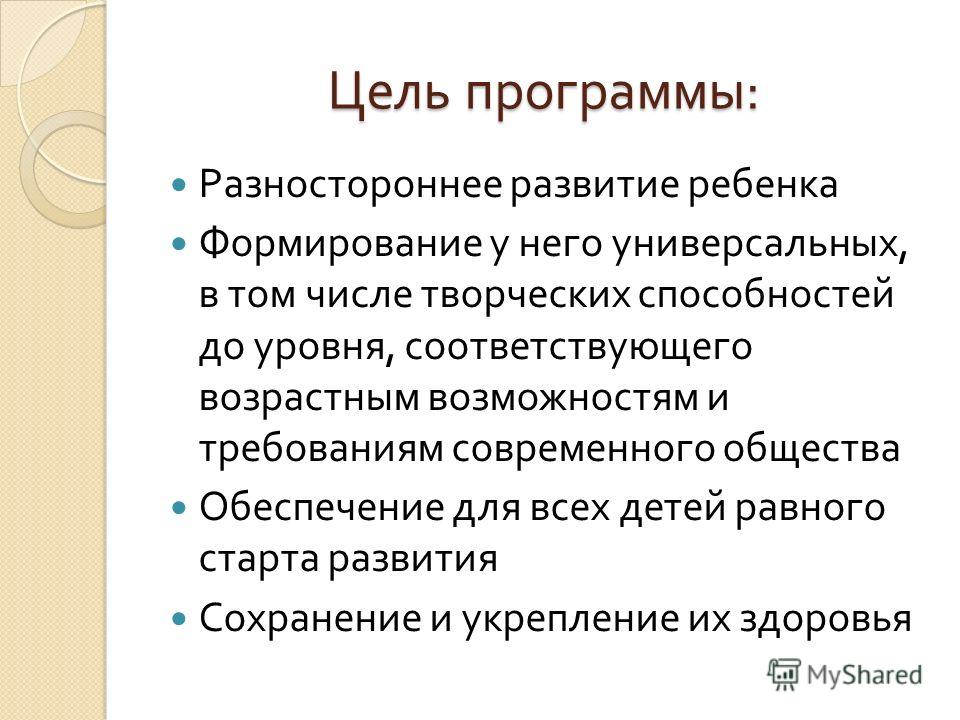
Program objectives: Forming the foundations of the holistic spiritual, moral and social development of a child's personality - a preschooler. Introducing him to the basic values of the Russian civilization based on the spiritual and moral traditions of the people. Developing communication skills, verbal interaction and managerial abilities of children. Creating conditions for successful adaptation of the child to primary school.
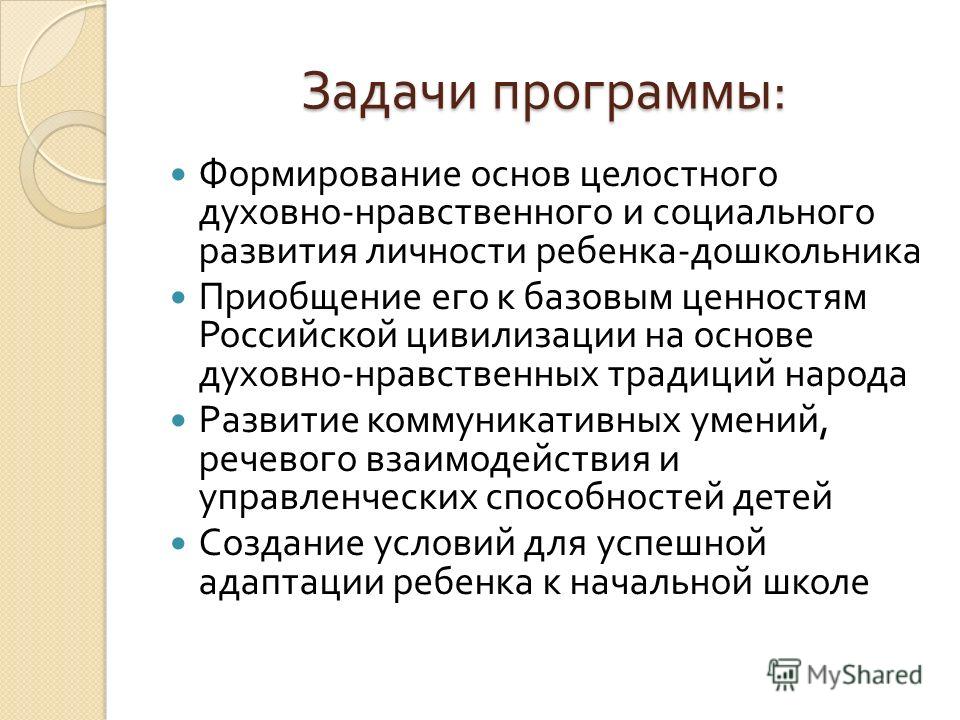
Principles of construction The implementation of the content of all educational areas is based on the following principles: 1 Implementation of the principle “from the general to the particular 2 Integrated principle 3 Creating problem situations 4 Visual modeling 5 Creating conditions for practical experimentation with different materials
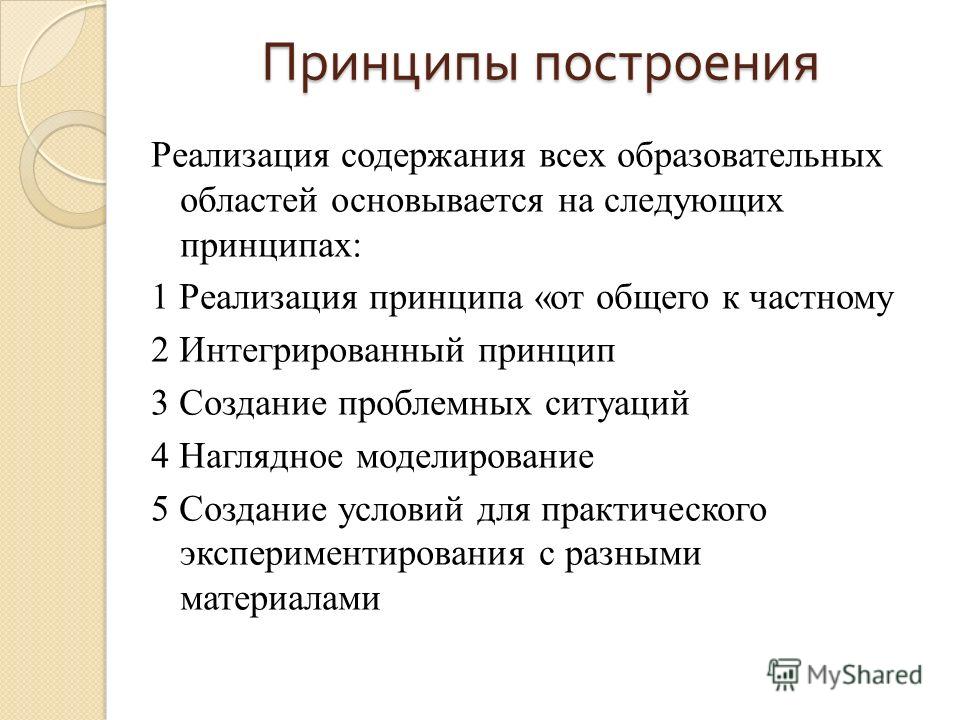
6 Consideration of individual features 7 Consideration of basic styles of perception 8 Creation of conditions for the use by the children themselves of content developed in the classroom in further free activity (play, drawing, designing, creating carnival costumes, etc.), which contributes to both development and self-development children. 9 Consideration of the specifics in the development of boys and girls

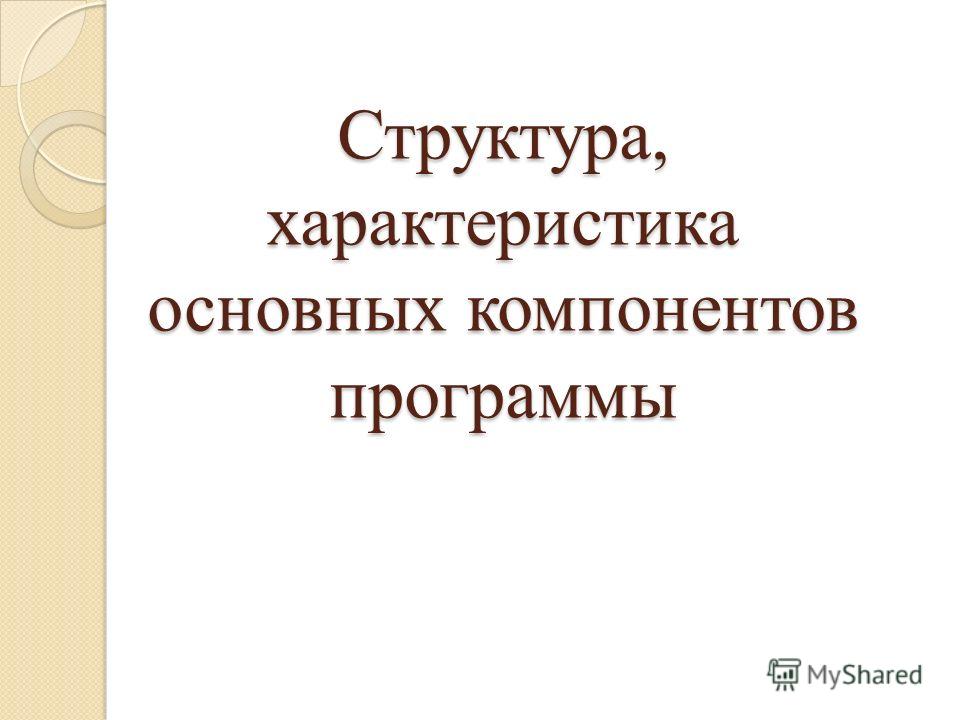
The program includes three main sections: targeted, informative and organizational, each of which reflects the obligatory part and the part formed by the participants of the educational process. 1) The target section includes: - explanatory note; - targets. 2) The substantive section defines the general content of the main educational program, ensuring the full development of children, taking into account their age and individual characteristics, and reveals the objectives of: - the development of specific activities; - the formation of a primary value orientation and socialization; - development of primary representations;

3) The organizational section defines the general framework for the organization of the educational process, as well as the mechanism for implementing the provisions of the main educational program. The content of the Program covers the following educational areas: communication and personal development; cognitive speech development; artistic and aesthetic development; physical development.
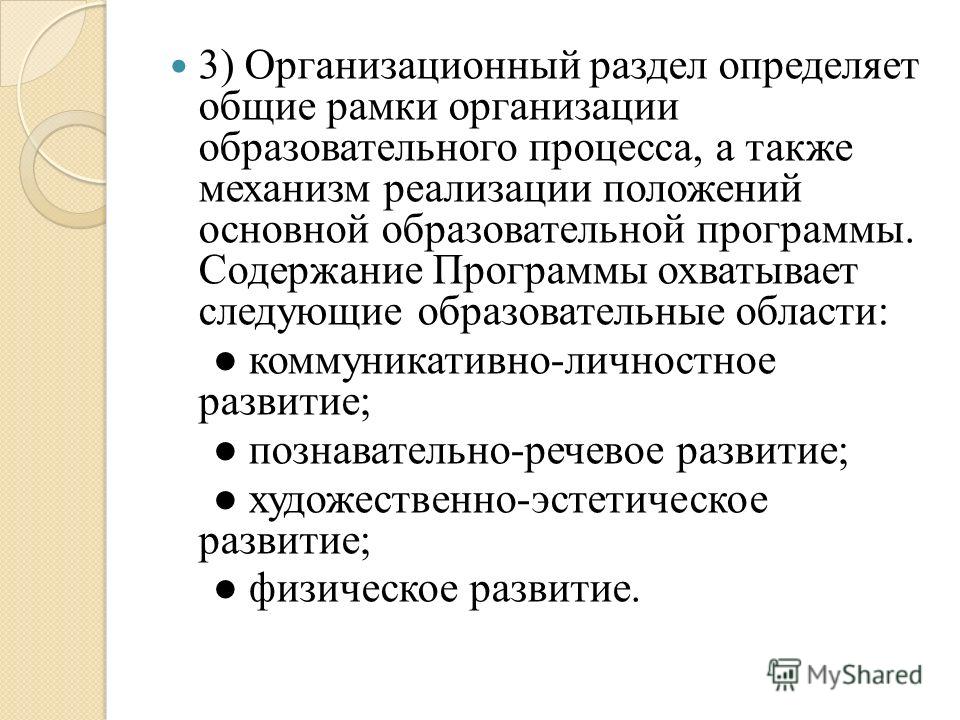
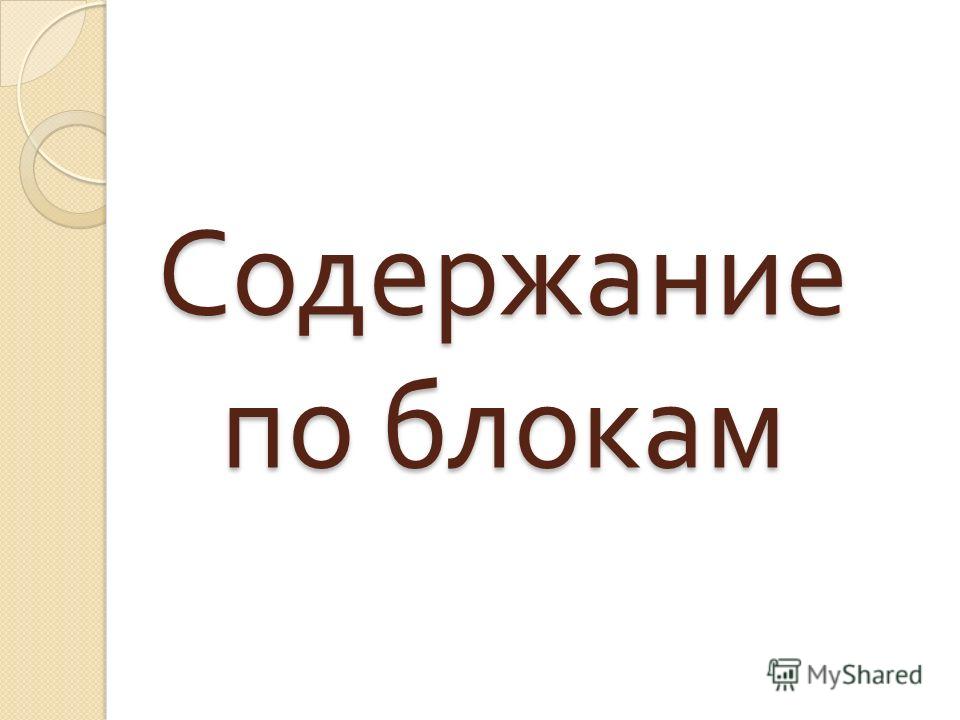
Early childhood Early childhood consists of two stages - infant (from birth to one year) and early age (from one to three years). In infancy, first of all, it is necessary to provide the child with communication with an adult, full feeding and adequate hygienic care. Especially necessary for the baby state of emotional well-being. It is an adult that creates all the conditions for normal psychophysical development.
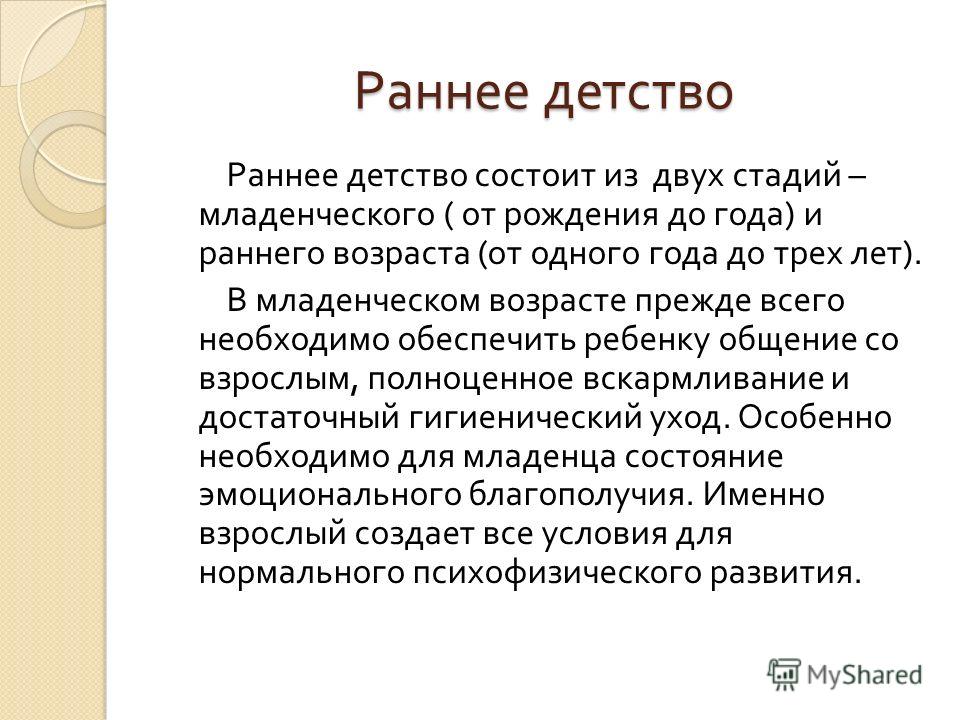

Preschool childhood Preschool childhood is a period that includes the younger preschool (3-5 years old) and the oldest preschool (5-7 years old) age. Leading the activities of amateur plot - role-playing game. In her, the child is first emotionally, and then intellectually develops the entire system of human relations, is oriented in the meanings of serious human activity.
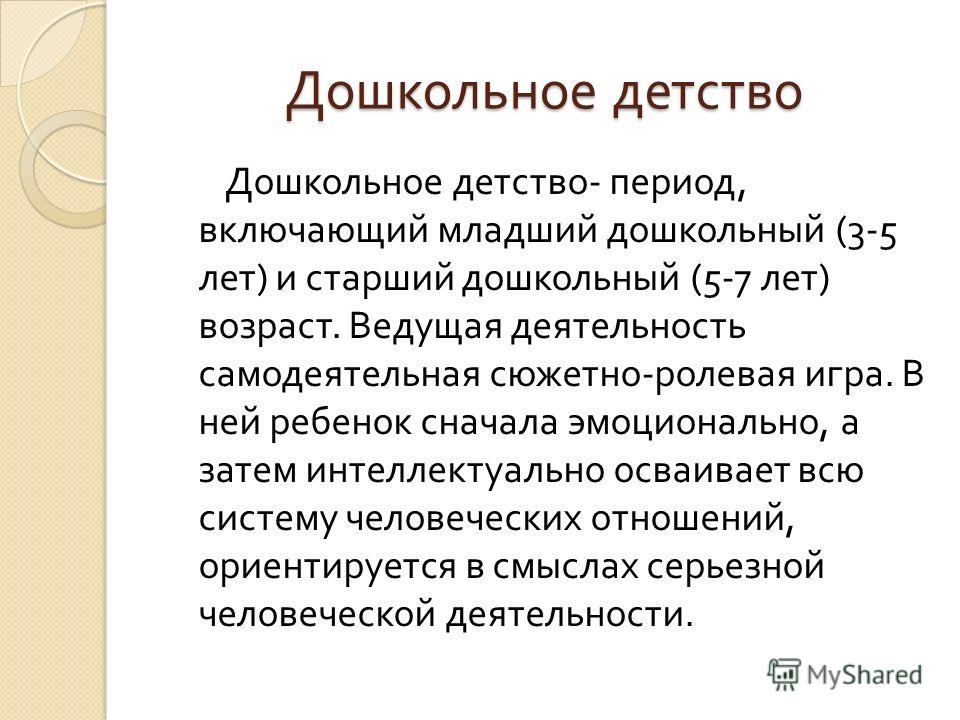
General conditions for the implementation of the program In order to ensure the formation in children of “basic trust in the world”, which forms the basis of its psychological security, adults create an atmosphere of benevolent relations among themselves, between children and children and adults. It is extremely important to ensure that every child has the opportunity to smoothly and painlessly enter the life of a kindergarten.

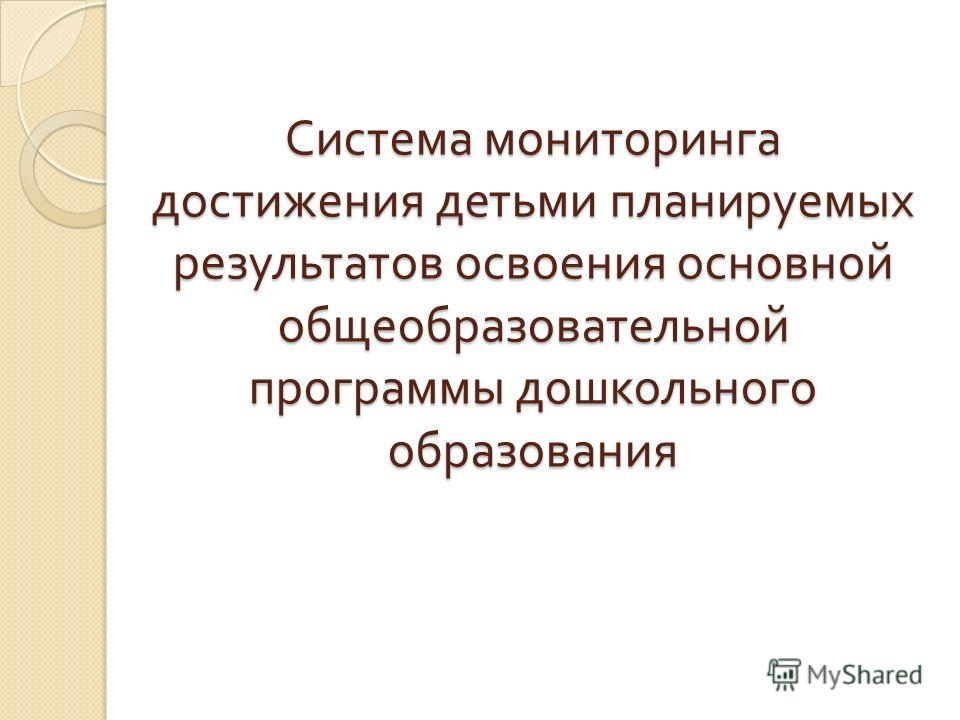
The basis for creating a monitoring system for children to achieve the planned results of mastering the basic general educational program of preschool education was laid down as follows: 1. Educational and educational work on the Sources Program is aimed not so much at mastering specific and specific content, as at mastering children activities, the enrichment of the diverse experience of activities and its synthesis
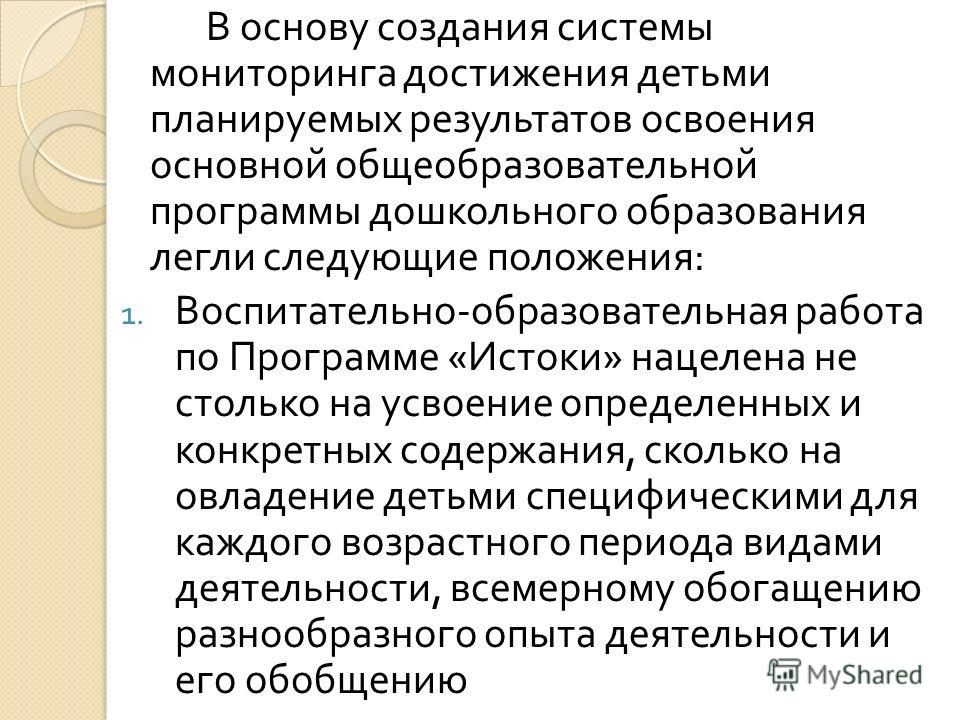
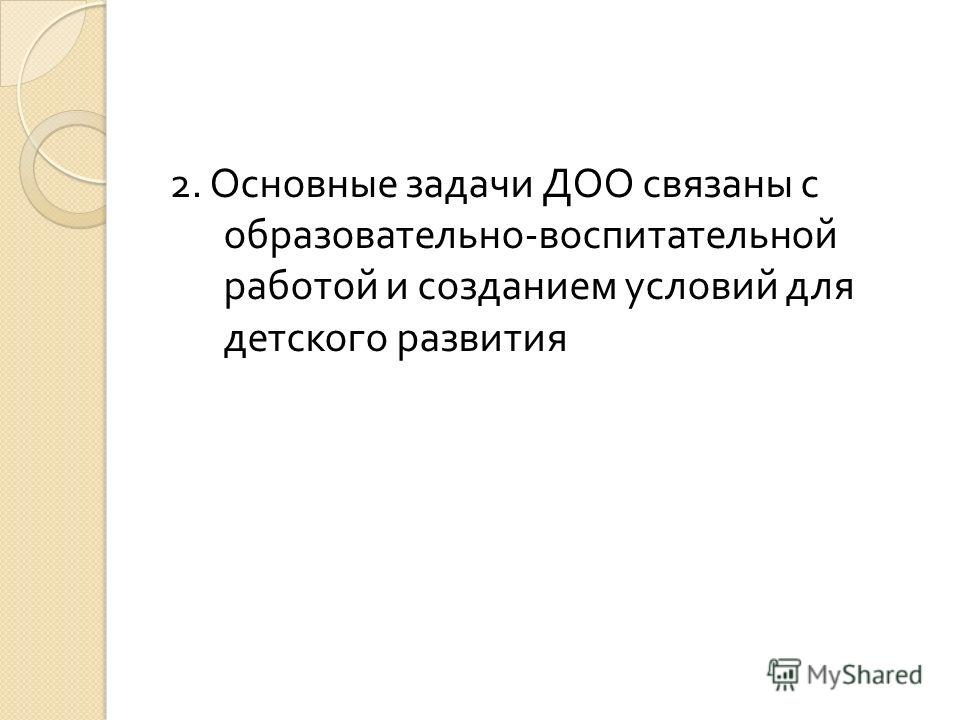
Distinctive features of the program The “Origins” program, like the “From Birth to School” program, reflects the education of children from birth to 7 years. However, the concept of psychological age is the basis of the Sources program. This allows you to flexibly build the pedagogical process, taking into account the uneven development of children and individualize it. The traditional occupation has not lost its value, but it is preserved mainly at the stage of acquaintance with the new material.

The program is based on an activity approach, each age has its own leading type of activity: infancy - communication, early age - subject activity, preschool age - play. The program almost does not say about the integration between educational areas.
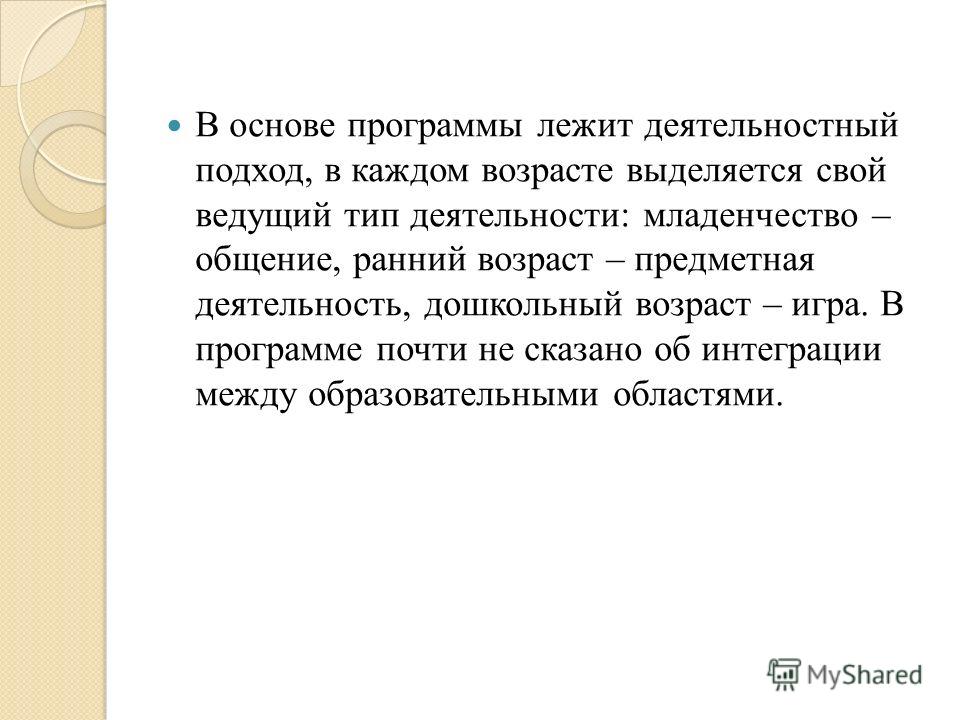
The subjective assessment of the program, based on many years of psychological and pedagogical research of the group of authors, takes into account achievements in the field of domestic and world pedagogy and psychology. The program presents the basic principles of organizing the life and activities of children in pre-school education, planning the educational process, creating a developing subject environment, cooperation with the family and the work of a psychologist. 22
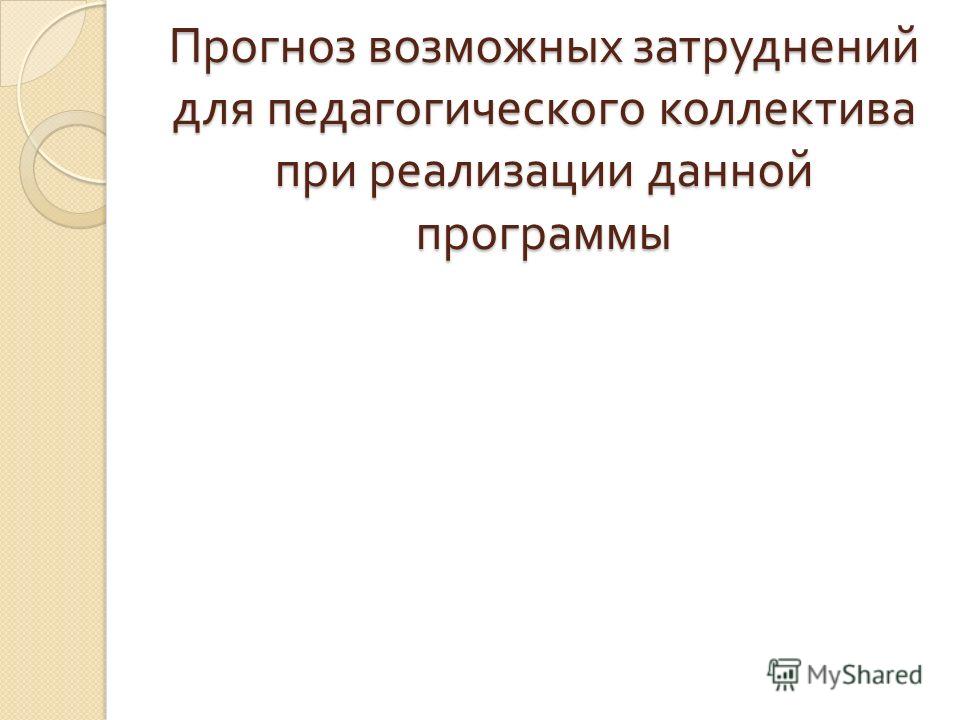
UDC 373 BBK 74.100 I89
5 to 6 months- shifts objects from hand to hand, removes the thumb when grasping objects, spreads or closes fingers when approaching an object before it touches it. Captures small objects with two fingers, large - with the whole palm. Indicative movements are shown in relation to familiar objects. Quickly and accurately guides the hand to the object, from whatever side it is, captures and holds it for a long time, performs its movement with each hand. Turns from the abdomen to the back. Lying on his stomach, moves, rearranging his hands, trying to crawl. It stands with the support under the arms, for both hands or for one arm.
6 to 8 months- produces a variety of actions with objects: tapping, throwing, brings to his mouth, examines his lips, tongue, turns, looks at from different points of view. Lying on his stomach, tightens his legs to his stomach, and, leaning on straightened hands, gets up on all fours. Actively creeps, leaning mainly on palms and knees. Trying to sit down himself, leaning on one arm. Independently moves from a prone position to a sitting position and vice versa. With and without the support of an adult, you can sit for a short time, straightening your back. Rises, holding the barrier, sits down. Spring legs, standing at the barrier. Steps, moves with support under the arms, behind both hands or along the support.
From 8 to 10 months -waves his hand, stretches his arms, performs “ladies” at the request of an adult. Crawls on the sloping surface of the hill and crawls off it. Able to sit on their own, sit firmly and stand for a short time. She can walk, holding on to two, and then by one hand of an adult for short distances from subject to subject.
10 to 12 months- works with objects in accordance with their purpose (closes, opens boxes, presses buttons, inserts, removes small objects from the box, strings rings on a stick or cord). Repeated movements appear, transferring actions from one object to another. Mimics the movements of adults.
He climbs on low objects, peels off them. Crawling under the obstacles. Creeps in different directions. He climbs onto the step of the children's slide and dismounts. Independently crouches from a standing position and vice versa, rises from a squatting position. It makes the first independent steps without support and support. Walking holding a moving support (gurney).
Educational field "Physical Education"
Educational tasks:
- to promote the timely mastery of movements based on positive emotional communication and joint actions of an adult with a child;
Develop sensorimotor activity;
To form actions with objects.
Up to 2.5-3 months- cause the child to focus on a bright colorful object, prompting him to follow his movement; lay on your back, belly; urge to raise the head, straighten the spine in position
lying on your side, stomach; keep your head in an upright position on the hands of an adult; talking to a child, smiling at him, to cause a reciprocal smile, lively movements, pronouncing sounds; create conditions for the support of the legs in the supine position, abdomen, and in the upright position on the hands of an adult, causing repulsion of the legs.
From 3 to5- 6 months- to help the child lift the torso, lying on his stomach, based on the forearm; rise, straightening his arms; roll from back to side, belly and back; initiate the direction of the hands to the toy, capture and hold it from different positions; encourage attempts to lie on your stomach to reach the toy, crawl up to it; push off legs from the support in an upright position with support under the arms.
From 5-6 to 10 months -help the child change poses: get up on all fours; sit down, lie down, sit down, sit without support; get up with the support of an adult; get up and down, holding on to the support; cross with support under the arms, behind both hands; cross, sticking with support; initiate actions with objects: inspect, shift from hand to hand, swing toys, throw them; perform actions that correspond to the properties of objects: roll balls, balls, compress a rubber toy that makes sounds; put small items in a box, open it and take out items; perform some movements, first repeating after an adult, and then at his verbal request (“Crawl to me”, “Sit down”); to cause an emotional reaction to gay music, while performing rschshchichnye movements - slightly squatting, "dancing", waving his hand.
From 9-10 to 12 months -improve previously mastered movements: teach crawling; crawl and descend the slope of the hill; crouch and stand up; crawl through the log; get up and sit down; take first steps yourself; walk for a gurney; walk independently, move from one subject to another; climb and descend the steps of the slide, walk without support at the request of an adult in a certain direction (“Come to me”); act with objects: bring familiar objects at the request of an adult, open and close the lid of the box, put rings on the rod and remove them, put one object on another (cube on a cube, etc.); to carry out games-entertainment (“Hide and Seek”, “Goat Horned”, “I will catch up with you, catch up with”, “Forty-white-sided”, etc.); initiate emotional responsiveness to play actions and dance music.
Get the full textSmall children are accommodated in spacious, bright rooms. For wakefulness, playpens are needed, both individual and large, for a group of children; sets of a variety of colorful items, toys, rattles, rings, balls, balls. After 6 months, children need more space and special gymnastic benefits: rollers, walkways, boards, ladders, sofas.
It is necessary to create situations that develop visual, auditory, vestibular-kinetic reactions, enriching tactile sensitivity, encouraging children to research activities.
Preschool childhood is a stage in the life of a child, in which the origins of the personality originate, a creative beginning is formed. Based on this principle, the educational program "Origins" was created.
“Sources”, being primarily a basic program, sets general guidelines in the upbringing, training and development of children.
It is based on humanistic principles, including the principle of dialogue between the child and the teacher in kindergarten as the basis for successful development. Such a dialogue implies that the child acts on a par with an adult in the role of an active subject of interaction, and not a passive perceiver, as it was considered previously.
In developing the program, great importance was attached to the registration of child psychology, namely the concept of psychological age as a stage in the development of a child.
The goals of the Sources program are:
- . the formation of a diversified personality at the age from birth to 7 years, its universal, including creative, abilities to the level corresponding to the age capabilities of the child;
- ensuring for every child an equal start of development;
- preservation and strengthening of children's health.
The program “Origins” was developed by a team of teachers and psychologists of the Center “Preschool Childhood” named after A. Zaporozhts under the guidance of the doctor of pedagogical sciences L. A. Paramonova. A large place in the program is given to the scientific position of A. V. Zaporozhets on the amplification (enrichment) of child development, the interconnection of all its sides.
The program is based on an activity approach. On the basis of it, activity develops from age to age, its content and form change.
Accordingly, based on the concept of the psychological age of the child, as well as the teachings of A.V. Zaporozhets, in the program "Sources" the following age stages are highlighted:
- early childhood - infancy (up to one year);
- early age (from one to three years);
- preschool childhood;
- younger preschool age (from three to five years);
- senior preschool age (from five to seven years).
Taking into account the age periodization of preschool childhood allows you to cover both general trends and the developmental perspective of each child individually. What makes the program "Origins" indispensable in the work of a kindergarten teacher. Based on the criteria of psychological age, he will be able to take into account the different pace of development of children and correctly implement an individual-oriented approach to them.
- social;
- cognitive;
- aesthetic;
- physical.
The program “Origins” describes in detail the features of the development of these aspects in infancy, early childhood, junior and senior preschool years. As one age changes to another, the hierarchy of main activities changes (communication, subject activity, play).
The game, as the basis of child development, is assigned a special place in the program “Sources”, it permeates all components of the program and its content as a whole.
By “social development” is meant the child’s communication with adults (parents and kindergarten teachers and family) and peers. In the program “Sources”, much attention is paid to communication, since it is social communication that is the basis for the formation of children's self-awareness, the assimilation of moral values, norms and traditions by a child.
- expansion and enrichment of the child's orientation in the surrounding world;
- the formation of ways and means of cognitive activity;
- development of the ability to see the total in a single phenomenon;
- the ability to find an independent solution to emerging problems.
The program "Origins" pays great attention to the aesthetic development of the child in kindergarten. By means of art (music, fiction, visual arts, etc.), children form an aesthetic attitude to the world and develop creative abilities.
- educating children about a healthy lifestyle, the importance of physical culture;
- formation of ideas about your own body;
- learning an adequate response to environmental change.
All of the above implants children conscious attitude to their health from an early age, teaches to avoid danger.
The Origins, a humanistic program, gives kindergarten teachers a broad and at the same time structured understanding of the characteristics of a child’s personality and the developmental directions of a child’s first seven years of life. For the first time, it was in the “Sources” program that teachers received clear guidelines for the development of a child’s personality, this makes the program indispensable and unique in its own way.
The “Origins” program opens up broad opportunities for teachers to use literally and creatively various educational models and technologies for the upbringing and education of children in kindergarten, which rightfully allows it to be the basis for many variable and special programs of the future.
Bibliography
1. Arushanova A.G., Durova N.V. Origins of the Dialogue: 3-5 Years: Lessons of Occupations.
2. Origins: Approximate basic general education program of pre-school education / Ed. L. A. Paramonova.
3. Motherland N. M. Complex-thematic planning of the educational process with children 4-5 years. The program "Origins".

Min. Transport Decree 1177
Space exploration - the most important stages
How to photograph goods for sale
Konica Minolta DiMAGE Z3 Digital Camera
Vasily Shukshin: biography